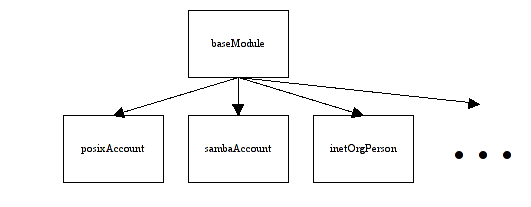The account modules control all the
functionality which is specific for LDAP accounts or parts of them.
E.g. they define the account detail pages where the user can edit
accounts, the profile editor sections and much more. They are the core
of LAM.
All account modules are saved in
lib/modules/.
If your module needs any include files etc. please save it in
lib/modules/<name of your module>.
Please take a look at the
module HowTo for
an example to write your own modules.
The complete specification for the module interface can be found
here.
Superclass
All
account modules should be
subclasses of the
baseModule.
This allows them to benefit from the meta data in the baseModule and
reduces very much the code since not the complete module interface has
to be implemented.
Module detection
New modules can simply be copied to
lib/modules.
LAM will check what files are inside the directory and provide the user
new modules automatically.
There is no extra configuration file.

